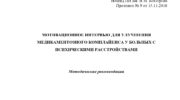Я долгое время провожу тренинги по мотивационному интервью (МИ) для сотрудников наркологических учреждений. Эффективность применения МИ для зависимых пациентов очень высока и подтверждена многочисленными исследованиями. Также я сам имею многолетний опыт работы с зависимыми и лично могу засвидетельствовать преимущества этого метода. Но волею судеб мне предстоит провести тренинг для сотрудников клиники эндокринологии и диетологии. Для того, чтобы обосновать необходимость и важность владения методом МИ врачами эндокринологами и диетологами, я предпринял небольшое исследование научной литературы, имеющейся на этот счет.
Что такое мотивационное интервью
Изменить поведение пациента, чтобы он выполнял назначения врача очень трудно. Определить наиболее эффективный подход, чтобы повысить приверженность пациента к терапии — очень важно. Мотивационное интервью (МИ) — это клинический подход, содержащий навыки коммуникации и коллаборации с клиентом, техники побуждения, способы подчеркнуть автономию, чтобы повысить мотивацию на пути к окончательному результату — изменению поведения. Принципы, лежащие в основе МИ включают эмпатию, развитие несоответствий, избегание споров и поддержку самоэффективности. Проведение МИ позволяет изменить существующие мысли и процессы саморегуляции таким образом, что это позволяет достичь приверженности к терапии.
Исследования МИ показывают, что интервенции, основанные на применении МИ эффективно влияют на изменение поведения в сторону здоровья. Они также связаны с положительными последствиями для здоровья, такими, как понижение АД, соблюдению диеты, отказу от курения, снижение уровня холестерина и лучшим контролем сахара крови.
Введение
Для клиентов очень важно изменить поведение, чтобы достичь успеха в терапевтической программе. Приверженность определяется как решение клиента получать и следовать инструкциям в отношении регуляции их состояния. В регуляции хронических заболеваний плохая приверженность приводит к худшим результатам в контексте медицинской помощи, повышает частоту госпитализаций и стоимость лечения. Можно сказать, что приверженность к лечению — «главный посредник между медицинской практикой и результатами у пациента». Стратегии улучшения приверженности к лечению должны включать ясные и конкретные рекомендации. Средний уровень отсутствия приверженности около 50% и в результате этого возрастает финансовая нагрузка на здравоохранение. Мотивационное интервью (МИ) — доказано более эффективно, чем другие стратегии, такие как традиционные стратегии информирования. Оно показало себя таким же эффективным, как когнитивная терапия приверженности, но с меньшими временными затратами.
МИ — это клинический подход, используемый для мотивации клиентов на изменения, помогая им исследовать и разрешить их амбивалентность и резистентность в отношении изменений, в клиент-центрированном подходе. МИ — это ориентированный на цель метод коммуникации. МИ — это пациент-центрированный подход к лечению, направленный на поддержание внутренней, истинной мотивации во всех людях, формируемой между клиницистом и клиентом. Клиницист направляет и руководствует клиента в направлении установленной цели, определяя потенциальные барьеры, и повышая самоэффективность решимость в достижении целей. Пациенты артикулируют свои собственные идеи и планы, вместо того, чтобы просто выслушать их от медицинских работников. Роль медицинских работников — способствовать, а не диктовать, и это ощущается как будто преодоление болезни это кооперация и равноправные отношения. МИ было изначально создано как модель лечения зависимостей, но сейчас оно модифицировано и для других случаев. МИ использует открытые вопросы, рефлексию и понимание уникальной натуры клиента. Оно также включает партнерство с каждым при оказании медицинской помощи. Техники МИ портативные (легко переносимые), низкотехнологичные и могут быть интегрированы в существующую консультативную модель. Интервенции, основанные на применении МИ короткие, состоящие из 3 сессий, длящиеся от 20 до 30 минут каждая, с последующим сопровождением по телефону. Интервенции проводятся медсестрами на дому у пациентов, во время визитов для оказания помощи на дому.
Готовность к изменениям определяется как определенное состояние на пути между отсутствием намерений до изменения поведения и поддержания изменений. МИ приводит к положительным результатам во всех аспектах заботы о здоровье, где требуется изменение поведения.
Метод исследования
Данная статья написана на основе обзора литературы от августа 2019 года ,
Результаты
Используя поисковую стратегию и методологию оценки, было приобретено 50 статей. Из них 25 не соответствовали критериям исследования и были исключены из этого исследования. Агрегация ревью по сравнимому дизайну статей показало, что их результаты были сгруппированы относительно применения МИ в областях, включающих сахарный диабет, сердечно-сосудистые заболевания, алкогольную зависимость, психические заболевания и шизофрению, хронические заболевания, ВИЧ и почечную недостаточность.
А. Клиенты с сахарным диабетом.
Исследование, проведенное Хлебовым и соавторами, исследовавшее МИ как интервенцию для улучшения степени здоровья и приверженности к терапии у клиентов с сердечно-сосудистыми проблемами. (7) Исследование показало, МИ влияет на приверженность к лечению и диабетические маркеры. В частности, клиенты, с которыми проводилось МИ придерживаются рекомендуемого уровня физической в 66,7% случаев, против 38,8%, получавших обычную помощь. Значительно лучше были показатели ИМТ и уровня глюкозы.
Motivational Interviewing to Improve Diabetes Outcomes in African Americans Adults With Diabetes Show all authorsDiane Orr Chlebowy, Peggy El-Mallakh, John Myers, … First Published April 14, 2014 Research Article Find in PubMedhttps://doi.org/10.1177/0193945914530522 Article informatio Abstract The purpose of this study was to determine the effect of a motivational interviewing intervention (MII) on regimen adherence and diabetes markers among African Americans with diabetes. Sixty-two participants were assigned to the usual care (UC; n = 36) or MII (n = 26) groups. UC participants received the usual clinic care. MII participants received a maximum of six motivational interviewing (MI) sessions over 3 months. Outcome variables were obtained at baseline and 3-month follow-up. Data were obtained using medical records, self-reports, and glucose monitor and accelerometer print-outs. MII significantly increased the odds of participants adhering to recommended physical activity level (66.7% vs. 38.8%, odds ratio = 2.92, 95% confidence interval = [1.6, 14.3], p = .018) and significantly decreased glucose levels (p = .043) and body mass index (p = .046) over time when compared with UC. Findings support using MI as an intervention for improving health outcomes and regimen adherence rates among the study population.
Другие исследования от Бовд-Фонтана и соавторов показали, что МИ, проводимое медицинскими работниками с пациентами с дислипидемией приводило к значительной редукции по всем липидным параметрам, кардиоваскулярным рискам, снижению веса и соблюдению диеты. (2)
Effectiveness of motivational interviewing in patients with dyslipidemia: a randomized cluster trial Abstract Background: It is known that making people change their habits is challenging. It is crucial to identify the most effective approach that general practitioners (GPs) should use to help their patients change unhealthy habits. The objective this study was to assess the efficacy of a multifactorial intervention based on Motivational Interviewing performed by general practitioners to enhance lipid levels in patients with dyslipidemia, as compared to standard care. Methods: A multicenter, controlled, randomized, cluster, two-parallel arm trial with a 12-month follow-up conducted in 25 community health centers of the Spanish. 38 GPs and 227 primary care patients with uncontrolled dyslipidemia were included in the trial. GPs performed an intervention based either on Motivational Interviewing (MI) or standard practice. Lipid levels were measured, and the control degree was analyzed based on the criteria of clinical guidelines. Results: 107 were assigned to the Experimental Group (EG) and 120 to the Control Group (CG). An overall improvement was achieved in total cholesterol levels (Mean Difference -MD- = -19.60; 95 % CI: -15.33 at -23.87 mg/dl; p < 0.001), LDL-cholesterol levels (MD = -13.78; 95 % CI: -9.77 at -17.79 mg/dl; p < 0.001) and triglycerides (MD = -19.14; CI 95 %: -11.29 at -26.99 mg/dl; p < 0.001). No differences were found between the two groups. However, when we assessed the degree of lipid control by combining cholesterol <200 mg/dl and LDL-cholesterol < 130 mg/dl parameters, it was observed that a higher percentage of patients achieved target figures in the EG versus CG (13.1 % vs. 5.0 %; adjusted OR = 5.77, 95 % CI: 1.67-19.91). Тем не менее, когда мы оценили контроль липидов, оценивая параметры комбинированного холестерина <200 mg/dl и холестерина липопротеидов низкой плотности <200 mg/dl, было видно, что больший процент пациентов достиг желаемых показателей в экспериментальной группе по сравнению с контрольной группой Conclusion: A Motivational Interviewing-based approach conducted by Primary Care physicians aimed at patients with dyslipidemia, achieved a significant reduction in all lipid parameters, cardiovascular risk, weight reduction and the adherence to the Mediterranean diet, similar to that obtained with the usual intervention and superior in the proportion of patients achieving combined lipid control goals and the level of physical exercise. Trial registration: the trial is registered in ClinicalTrials.gov ( NCT01282190 ; January 21, 2011).

Исследования показали, что использование МИ будет решением проблем в лечении диабета 2 типа и снижения риска сердечно-сосудистых заболеваний в реальной жизни(8).
Motivational interviewing and problem solving treatment to reduce type 2 diabetes and cardiovascular disease risk in real life: a randomized controlled trial Abstract Background: Intensive lifestyle interventions in well-controlled settings are effective in lowering the risk of chronic diseases such as type 2 diabetes (T2DM) and cardiovascular diseases (CVD), but there are still no effective lifestyle interventions for everyday practice. In the Hoorn Prevention Study we aimed to assess the effectiveness of a primary care based lifestyle intervention to reduce the estimated risk of developing T2DM and for CVD mortality, and to motivate changes in lifestyle behaviors. Methods: The Hoorn Prevention Study is a parallel group randomized controlled trial, implemented in the region of West-Friesland, the Netherlands. 622 adults with ≥10% estimated risk of T2DM and/or CVD mortality were randomly assigned and monitored over a period of 12 months. The intervention group (n=314) received a theory-based lifestyle intervention based on an innovative combination of motivational interviewing and problem solving treatment, provided by trained practice nurses in 12 general practices. The control group (n=308) received existing health brochures. Primary outcomes was the estimated diabetes risk according to the formula of the Atherosclerosis Risk In Communities (ARIC) Study, and the estimated risk for CVD mortality according to the Systematic COronary Risk Evaluation (SCORE) formula. Secondary outcomes included lifestyle behavior (diet, physical activity and smoking). The research assistants, the principal investigator and the general practitioners were blinded to group assignment. Linear and logistic regression analysis was applied to examine the between-group differences in each outcome measure, adjusted for baseline values. Results: 536 (86.2%) of the 622 participants (age 43.5 years) completed the 6-month follow-up, and 502 (81.2%) completed the 12-month follow-up. The mean baseline T2DM risk was 18.9% (SD 8.2) and the mean CVD mortality risk was 3.8% (SD 3.0). The intervention group participated in a median of 2 sessions. Intention-to-treat analyses showed no significant differences in outcomes between the two groups at 6 or 12-months follow-up. Conclusions: The lifestyle intervention was not more effective than health brochures in reducing risk scores for T2DM and CVD or improving lifestyle behavior in an at-risk population. Trial registration: Current Controlled Trials: ISRCTN59358434.
Условия лечения и последующий анализ результатов показали значительные различие между двумя группами. Усиление интервенций МИ при сахарном диабете было исследовано Морулой и соавт, который утверждает, что клиенты показывают улучшение в 6-месячный период в качестве получаемой помощи лечения диабета. (9)
A pilot study of a Community Health Agent-led type 2 diabetes self-management program using Motivational Interviewing-based approaches in a public primary care center in São Paulo, Brazil Abstract Background: Rates of noncommunicable diseases (NCDs) such as type 2 diabetes are escalating in low and middle-income countries such as Brazil. Scalable primary care-based interventions are needed to improve self-management and clinical outcomes of adults with diabetes. This pilot study examines the feasibility, acceptability, and outcomes of training community health agents (CHAs) in Motivational Interviewing (MI)-based counseling for patients with poorly controlled diabetes in a primary care center in São Paulo, Brazil. Methods: Nineteen salaried CHAs participated in 32 h of training in MI and behavioral action planning. With support from booster training sessions, they used these skills in their regular monthly home visits over a 6 month period with 57 diabetes patients with baseline HbA1cs > 7.0%. The primary outcome was patients’ reports of the quality of diabetes care as measured by the Portuguese version of the Patient Assessment of Chronic Illness Care (PACIC) scale. Secondary outcomes included changes in patients’ reported diabetes self-management behaviors and in A1c, blood pressure, cholesterol and triglycerides. We also examined CHAs’ fidelity to and experiences with the intervention. Results: Patients reported improvements over the 6 month period in quality of diabetes care received (PACIC score improved 33 (+/-19) to 68 (+/-21) (p < .001)). They reported increases in physical activity (p = .001), consumption of fruits and vegetables (p < .001) and medication adherence (p = .002), but no decreases in consumption of high-fat foods (p = .402) or sweets (p = .436). Participants had mean 6-month A1c levels 0.34% points lower than at baseline (p = .08) and improved mean LDL (-16.1 mg/dL, p = .005) and triglyceride levels (-38.725 mg/dL, p = .002). Of the 16 CHAs observed in fidelity assessments, 13 were categorized as medium- or high-performing on MI skills, while 3 were low-performing. CHAs expressed enthusiasm about learning new skills, and many described a shift from advice-giving to encouraging patients to define their own goals. Conclusion: In resource-scarce settings, it is essential to fully utilize existing primary care resources to stem the epidemic of diabetes and other NCDs. Our pilot results support the potential of training CHAs to incorporate effective diabetes self-management support into their routine patient encounters. Trial registration: NCT02994095 12/14/2016 Registered retrospectively. Keywords: Brazil; Community health worker; Diabetes; Motivational Interviewing; Pilot study; Primary care; Self-management.
Исследование сообщает, что был повышен уровень физической активности, употребление фруктов и овощей и приверженности к лекарственной терапии. Другое исследование основано на том, что МИ — это не одна интервенция. (10) Оно включает различные специфические техники для того, чтобы воодушевить на изменения поведения и оно требует тренировки и времени, чтобы воплотиться в жизнь. Результаты исследования поддерживают применение МИ.
Б. Клиенты с сердечно-сосудистыми заболеваниями.
Предыдущее исследование, проведенное Аль-Гамни и соавторами было основано на RCT исследовании. (11) С клиентом проводилось короткое, полуструктурированное интервью, чтобы определить уровень приверженности к лечению и определить факторы, предсказывающие отсутствие приверженности. Результаты показали, что МИ проводимое медсестрами могло усилить приверженность к лечению.
Behaviour change interventions to improve medication adherence in patients with cardiac disease: Protocol for a mixed methods study including a pilot randomised controlled trial Abstract Background Suboptimal adherence to medication increases mortality and morbidity; individually tailored supportive interventions can improve patients’ adherence to their medication regimens. Aims The study aims to use a pilot randomised controlled trial (RCT) to test the hypothesis that a theory-based, nurse-led, multi-faceted intervention comprising motivational interviewing techniques and text message reminders in addition to standard care will better promote medication adherence in cardiac patients compared to standard care alone. The pilot study will assess self-reported adherence or non-adherence to cardiovascular medication in patients referred to a cardiac rehabilitation program following hospital admission for an acute cardiac event and test the feasibility of the intervention. The study will examine the role of individual, behavioural and environmental factors in predicting medication non-adherence in patients with CVD. Methods This is a mixed- methods study including a nested pilot RCT. Twenty-eight cardiac patients will be recruited; an estimated sample of nine patients in each group will be required for the pilot RCT with 80% power to detect a moderate effect size at 5% significance, and assuming 50% loss to follow-up over the six month intervention. Participants will complete a paper-based survey (Phase one), followed by a brief semi-structured interview (Phase two) to identify their level of adherence to medication and determine factors predictive of non-adherence. Participants identified as ‘non-adherent’ will be eligible for the pilot randomised trial, where they will be randomly allocated to receive either the motivational interview plus text message reminders and standard care, or standard care alone. Discussion Nurse-led multi-faceted interventions have the potential to enhance adherence to cardiac medications. The results of this study may have relevance for cardiac patients in other settings, and for long-term medication users with other chronic diseases.
Другое исследование Хардкастла и соавторов сообщает, что есть значительная разница между группами пациентов с ожирением и гиперхолестеринемией от исходного уровня, таким образом показано значительное улучшение ИМТ и уровня холестерина между группами, где проводилась интервенция и контрольной. (12)
Effectiveness of a motivational interviewing intervention on weight loss, physical activity and cardiovascular disease risk factors: a randomised controlled trial with a 12-month post-intervention follow-up Abstract Background: Intensive diet and physical activity interventions have been found to reduce cardiovascular disease (CVD) risk, but are resource intensive. The American Heart Association recently recommended motivational interviewing (MI) as an effective approach for low-intensity interventions to promote health-related outcomes such as weight loss. However, there is limited research evaluating the long-term effectiveness of MI-based interventions on health-related outcomes associated with CVD risk. The current research evaluated the effectiveness of a six-month low-intensity MI intervention in a UK primary-care setting in maintaining reductions in CVD risk factors at12 months post-intervention. Methods: Primary-care patients were randomised to an intervention group that received standard exercise and nutrition information plus up to five face-to-face MI sessions, delivered by a physical activity specialist and registered dietician over a 6-month period, or to a minimal intervention comparison group that received the standard information only. Follow-up measures of behavioural (vigorous and moderate physical activity, walking, physical activity stage-of-change, fruit and vegetable intake, and dietary fat intake) and biomedical (weight, body mass index [BMI], blood pressure, cholesterol) outcomes were taken immediately post-intervention and at a 12-month follow-up occasion. Results: Intent-to-treat analyses revealed significant differences between groups for walking and cholesterol. Obese and hypercholesterolemic patients at baseline exhibited significant improvements in BMI and cholesterol respectively among those allocated to the intervention group compared to the comparison group. Post-intervention improvements in other health-related outcomes including blood pressure, weight, and BMI were not maintained. Conclusions: The present study suggests that a low-intensity MI counselling intervention is effective in bringing about long-term changes in some, but not all, health-related outcomes (walking, cholesterol levels) associated with CVD risk. The intervention was particularly effective for patients with elevated levels of CVD risk factors at baseline. Based on these findings future interventions should be conducted in a primary care setting and target patients with high risk of CVD. Future research should investigate how the long-term gains in health-related outcomes brought about by the MI-counselling intervention in the current study could be extended to a wider range of health outcomes.
По результату исследования сделан вывод, что консультирование с применением МИ низкой интенсивности, приводит к долгосрочным изменениям для многих, но не для всех связанных со здоровьем улучшений. Другое исследование собрало 1704 участника, которые были рандомизированы по получению МИ интервенций, проводимых для внедрения практик здорового образа жизни, проводимых в группе, в индивидуальных форматах или включенных в их текущую программу медицинской помощи. (13)
По ссылке полная статья: Comparing the effectiveness of an enhanced MOtiVational intErviewing InTervention (MOVE IT) with usual care for reducing cardiovascular risk in high risk subjects: study protocol for a randomised controlled trial Abstract Background Interventions targeting multiple risk factors for cardiovascular disease (CVD), including poor diet and physical inactivity, are more effective than interventions targeting a single risk factor. A motivational interviewing (MI) intervention can provide modest dietary improvements and physical activity increases, while adding cognitive behaviour therapy (CBT) skills may enhance the effects of MI. We designed a randomised controlled trial (RCT) to examine whether specific behaviour change techniques integrating MI and CBT result in favourable changes in weight and physical activity in those at high risk of CVD. A group and individual intervention will be compared to usual care. A group intervention offers potential benefits from social support and may be more cost effective. Methods/Design Individuals aged between 40 and 74 years in 11 South London Clinical Commissioning Groups who are at high risk of developing CVD (≥20%) in the next 10 years will be recruited. A sample of 1,704 participants will be randomised to receive the enhanced MI intervention, delivered by trained healthy lifestyle facilitators (HLFs), in group or individual formats, in 10 sessions (plus an introductory session) over one year, or usual care. Randomisation will be conducted by King’s College London Clinical Trials Unit and researchers collecting outcome data will be blinded to treatment allocation. At 12-month and 24-month follow-up assessments, primary outcomes will be change in weight and physical activity (average steps per day). Secondary outcomes include changes in low-density lipoprotein cholesterol and CVD risk score. Incidence of CVD events since baseline will be recorded. A process evaluation will be conducted to evaluate factors which impact on delivery, adherence and outcome. An economic evaluation will estimate relative cost-effectiveness of each type of intervention delivery. Discussion This RCT assesses the effectiveness of a healthy lifestyle intervention for people at high risk of CVD. Benefits of the study include the ethnic and socioeconomic diversity of the study population and that, via social support within the group setting and long-term follow-up period, the intervention offers the potential to support maintenance of a healthy lifestyle.
Первичные результаты показали изменения веса и физического здоровья. Вторичные последствия включают изменения холестерина липопротеидов низкой плотности и оценки шкалы риска сосудистых заболеваний (Cerebro Vascular Disease (CVD) risk scores).
Далее в статье рассматривается эффективность применения МИ у клиентов с ВИЧ, алкогольной зависимостью, почечной недостаточностью, где также приведены доказательства эффективности метода в плане приверженности терапии, изменения поведения.
Обсуждение
Главные компоненты МИ — RULE. МИ руководствуется четырьмя руководящими принципами, представленными акронимом. Resistance «Сопротивляйся выпрямительному рефлексу» Выпрямительный рефлекс возникает немедленно при выявлении рисков или проблемы с имеющимся поведением пациента. Understanding — «понимание мотивации клиента» У клиента есть собственные причины для того, чтобы изменить поведение. Listening — правильно слушать. Правильно слушать — значит больше, чем просто использовать уши для того, чтобы слышать слова, которые произносит клиент. И это не то же самое, что задавать вопросы. Empowering — уполномочить клиента, для того, чтобы исследовать собственные идеи клиента об изменениях, которые улучшат его здоровье. Эмпатия — важный навык МИ. Эмпатия — значит не осуждать, но и не значит соглашаться все время с клиентом. Она демонстрирует, как консультант может быть терпеливым. Подход МИ представлен навыками ОАРС : открытые вопросы, аффирмации, рефлексивное слушание, суммирование. Открытые вопросы не структурированные и не предопределяют ответ. Аффирмация — это утверждение, которое раскрывает сильное качество клиента и это помогает консультанту создавать терапевтические отношения с клиентами. Слушать, применяя рефлексии — еще один важный навык МИ. Использование рефлексий дает возможность консультанту показать свое понимание ситуации клиента и почувствовать клиенту, что его понимают.
Заключение
МИ — стиль ведения беседы, созданный для того, чтобы способствовать изменению поведения и определяется серией направленных коммуникативных навыков для








